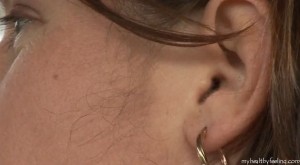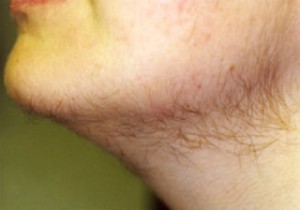Hirsutism is an unwanted condition which results in the growth of male-pattern hair in women. The condition leads to the growth of increased quantities of pigmented and coarse hair in such regions of the body that are typical for male hair growth. For example, body parts such as the chest, face and back.
Most cases of excess body hair are determined by the genetic makeup of individuals. Hirsutism results from the presence of increased amounts of male hormones called androgen, especially testosterone. Hirsutism may also be caused due to a family or ethic trait.
Women can effectively treat cases of hirsutism with a combination of medical therapies and self care methods.
Hirsutism symptoms
The primary sign of hirsutism is the presence of pigmented and coarse hair that occurs on the body, where women typically do not have body hair. Such areas include the back, chest and the face. In cases, where hirsutism is caused due to excess levesls of androgen, then other symptoms of the condition appear over a period of time through a process known as virilization.
Some of the signs and symptoms of virilization are as follows:
• An ever deepening voice quality
• Increased occurrence of acne
• Balding
• Decreased size of the breasts
• Increased muscle mass
• Irregular menstrual periods
Hirsutism, itself does not result in any serious medical complications, but the accompanying hormonal changes in the body can result in many medical conditions. Additionally, the presence of unwanted body hair can result in severe stress and other psychological problems in women.
Causes of hirsutism
• The body of all individuals is covered with colorless and very thin hairs known as vellus hairs, till the time they attain puberty. As individuals undergo physical maturity, the male hormones known as androgens, assist the vellus hairs to become denser, darker, curlier and coarser in certain regions of the body. Such hairs are called terminal hairs. Such unwanted development of terminal hairs in women can be caused due to excessive amounts of androgen or due to greater sensitivity of the hair follicles to the presence of androgens.
• Most of the women affected by mild hirsutism have high levels of androgen. However, severe cases of hirsutism generally do not develop due to excess levels of androgen.
Some of the reasons for high levels of androgen are mentioned below:
• Polycystic ovary syndrome: This condition has been identified as the most common cause of hirsutism and generally results from an imbalance of the sex hormones. The condition may lead to symptoms such as infertility, irregular menstrual periods, obesity and on some occasions several cysts on the ovaries.
• Congenital adrenal hyperplasia: It is an inherited condition and shows various symptoms such as:
o On rare occasions, the presence of androgen-secreting tumors in the adrenal glands or in the ovaries may cause hirsutism
o The production of abnormal levels of androgen and cortisol by the adrenal glands
o Certain medications can lead to the development of hirsutism. For example the drug called danazol used to treat endometriosis in women can cause the condition.
• Cushing’s syndrome: It is a condition that develops due to the exposure of the body to increased levels of cortisol. This is a steroid hormone that is involved in the response of the body to elevated stress. The condition may be caused due to excess production of cortisol by the adrenal glands, which are tiny hormone secreting glands situation above the kidneys, or due to long-term consumption of drugs high in cortisol. Thus excessive levels of cortisol lead to disturbances in the balance of the sex hormones leading to hirsutism.
• Idiopathic hirsutism is caused in women who do not have any identifiable causes such as irregular menstrual periods or abnormal androgen levels. Such forms of hirsutism generally occur in women of ethnic origins such as South Asians, Middle Eastern and Mediterranean ancestry
There are many risk factors that increase the risk of developing hirsutism. Some of them are discussed below:
• Women of certain ethnic ancestries are at greater risk to develop the condition than others
• A family history of medical conditions such as polycystic ovary syndrome and congenital adrenal hyperplasia, places women at greater risk to develop hirsutism
Hirsutism treatment
Hirsutism can be treated with an effective combination of hair-removal therapies, self-care methods, and medications. Some of them are listed below:
Hair removal therapies include the below mentioned procedures-
• It is an expensive way to remove unwanted hair from the skin. It can result in pain and there are chances of hair regrowth. Side effects include changes in skin color, swelling and redness.
• Electrolysis which involves permanent removal of the unwanted hair. The therapy can be painful and can lead to either darkening or lightening of the treated skin, but no scarring.
Medical therapies include-
• Intake of anti-androgen drugs that block androgens and do not let them attach to their receptors in the body
• The intake of oral contraceptives such as hormonal contraceptives or birth control pills to reduce the production of androgen by the ovaries.
• Topical medications that can be applied directly on the affected areas. They do not help in getting rid of unwanted hair, but slow down the growth of new hair.
Self care methods include the use of chemical depilatories and other methods of hair removal such as waxing, shaving and plucking.
Hirsutism pictures


I loved as much as you’ll receive carried out right here. The sketch is attractive, your authored subject matter stylish. nonetheless, you command get got an edginess over that you wish be delivering the following. unwell unquestionably come more formerly again as exactly the same nearly a lot often inside case you shield this increase.